
The S and T class was a class of sixteen destroyers of the Royal Navy launched in 1942–1943. They were built as two flotillas, known as the 5th and 6th Emergency Flotilla, and they served as fleet and convoy escorts in World War II.
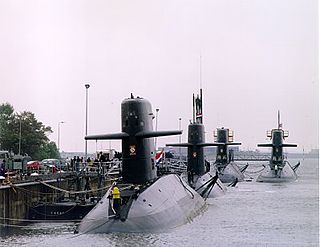
The Walrus-class submarine is the only submarine class currently in operation in the Royal Netherlands Navy. The boats have been in service since 1990 and are all named after sea mammals.

HNLMS Kortenaer was an Admiralen-class destroyer of the Royal Netherlands Navy, named after 17th century Dutch Admiral Egbert Bartholomeusz Kortenaer.

The Zwaardvis-class submarine ("Swordfish") is a class of conventional attack submarines that were built to strengthen the Royal Netherlands Navy. The Dutch government opted for the choice to not replace the two Zwaardvis-class submarines with either more Walrus-class submarines, or submarines of a new design.

HNLMS Van Ghent was an Admiralen-class destroyer built for the Royal Netherlands Navy in the 1920s. The destroyer served in the Netherlands East Indies but was wrecked after running aground in 1942.
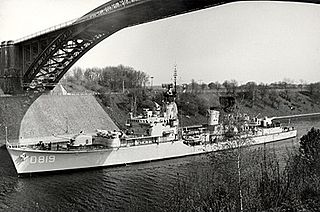
The Friesland-class destroyers were built for the Royal Netherlands Navy in the 1950s. They were a larger modified version of the Holland class with more powerful machinery. Eight ships were built. They were replaced by the Kortenaer-class frigates in the early 1980s and seven ships were sold to the Peruvian Navy where they served until 1991. The main armament was supplied by Bofors.
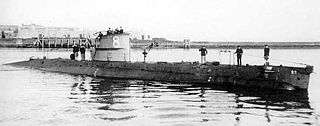
HMS H6 was a British H-class submarine of the Royal Navy built by Canadian Vickers & Co. during World War I.

The Dolfijn-class submarines of the Royal Netherlands Navy are a class of four submarines; Dolfijn, Zeehond, Potvis and Tonijn. They were built in the late 1950s and the early 1960s. They were the first indigenous submarines built in the Netherlands and for the Royal Netherlands Navy after World War II. In the Netherlands they are also known as "three cylinder" submarines.

The Royal Netherlands Navy Submarine Service is a department within the Royal Netherlands Navy that is responsible for the deployment of Dutch submarines. It was established out of the Netherlands Torpedo Service on 21 December 1906, and merged with the Netherlands Mine Service on 15 July 2005.

O 19, laid down as K XIX, was an O 19-class submarine of the Royal Netherlands Navy that saw service during World War II. O 19, along with her sister ship O 20, were the first submarines in the world to be equipped with a submarine snorkel that allowed the submarine to run its diesel engines while submerged.

The O 19 class was a class of two submarines, built for the Royal Netherlands Navy by Fijenoord, Rotterdam. The ships were designed as submarine minelayer for operations in both European and colonies waters. The class comprised O 19 and O 20 and were the first submarines in the world to be equipped with a submarine snorkel that allowed the submarine to run its diesel engines while submerged. The submarines diving depth was 100 m (330 ft). These units were very similar to earlier Polish Orzeł class, with a reduced torpedo battery and 10 vertical mine tubes fitted on each beam.

The O 21 class was a class of seven submarines, built for the Royal Netherlands Navy. The boats were still incomplete at the start of the German invasion of the Netherlands O 21, O 22, O 23 and O 24 were hastily launched and escaped to the United Kingdom. O 25, O 26 and O 27 were not able to escape and were captured by the German forces. The Kriegsmarine ordered the completion of the boats and they entered German service as UD-3, UD-4 and UD-5. The submarines diving depth was 100 meters (330 ft).
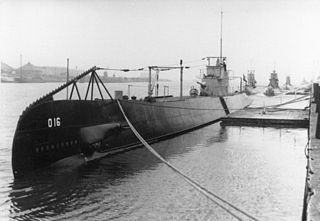
HNLMS O 16 was a submarine of the Royal Netherlands Navy that saw service during World War II. She was the first submarine of the RNN manufactured from high-quality Steel 52, with the ability to dive at a depth of 80 metres (260 ft).
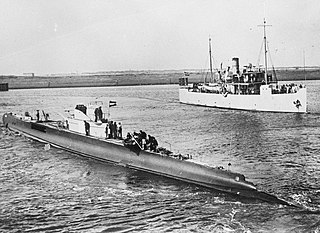
K XVII was one of five K XIV-class submarines built for the Royal Netherlands Navy. She served during World War II.

The Van Amstel class was a class of six frigates that were built during the Second World War in the United States and served as Cannon-class destroyer escort during that war. After the war the destroyer escorts were loaned to the Dutch navy as part of the MDAP and from 1950 to 1967 served as the Van Amstel-class frigates.

HNLMS Dolfijn (S808) is a Walrus-class submarine of the Royal Netherlands Navy. She entered service in 1993 as the third submarine of the Walrus class, after HNLMS Walrus and HNLMS Zeeleeuw. Dolfijn has been deployed both for naval exercises and in combat operations around the world. Furthermore, the submarine plays an important role by performing intelligence operations.

HNLMS Holland (D808) was the lead ship of her class of four destroyers built for the Royal Netherlands Navy in the early 1950s. HNLMS Holland is named after a former province of the Kingdom of the Netherlands and was the twentieth ship with this name. In 1978 the ship was taken out of service and sold to Peru where it was renamed Garcia y Garcia. The ship's radio call sign was "PAOP".

HNLMS Noord-Brabant (D810) was a Holland-class anti-submarine destroyer of the Royal Netherlands Navy. The ship was from 1955 to 1974 in Dutch service. On 9 January 1974, HNLMS Noord-Brabant was rammed amidships by an English merchant ship. The damage was estimated to be expensive so the Royal Netherlands Navy decided to not repair the damage but instead decommission the ship earlier than planned. The ship's radio call sign was "PAIP".
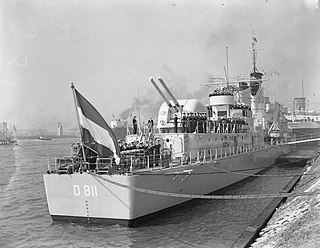
HNLMS Gelderland (D811) was a destroyer of the Holland class. The ship was in service with the Royal Netherlands Navy from 1955 to 1973. The destroyer was named after the Dutch province of Gelderland and was the twenty-first ship with this name. In 1973 the ship was taken out of service, after which it was given a berth in Amsterdam for the Technical Training Royal Navy (TOKM) school. During her service the ship's radio call sign was "PARY". The ship was sold for scrapping in 1988.

The Roofdier class was a class of six frigates that were built in the United States as Patrol Craft Escorts (PCE) for the Netherlands. The frigates were loaned to the Royal Netherlands Navy as part of the Mutual Defense Assistance Act (MDAP) and from 1954 to 1984 served as the Roofdier-class frigates.



















